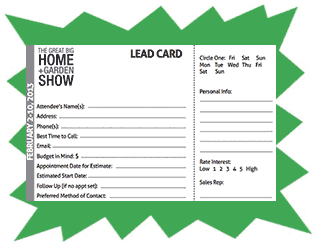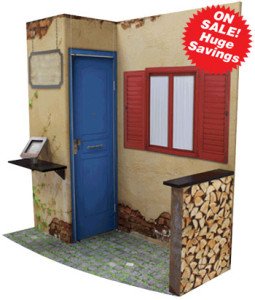How To Create The Perfect Lead Card

Sample leadcard (found at marketplaceevents.com)
Badge scanners are efficient, but don’t write off the traditional lead card just yet. It still has a lot going for it that can make your shows more successful.
I wish I could show you an example of the absolute, perfect lead card. But I can’t. Lead cards are unique to the companies they’re created for, as each organization is seeking different information to help their sales force follow up with show leads.
What I can do is tell you a few things your lead card might be missing that will make the sales team’s process of following up with those leads more effective, efficient and fruitful. The truth is, most lead cards are missing vital information that, if included, could give your sales force a huge advantage when it comes to making follow up calls. This is an advantage that badge scanners just don’t offer.
Let’s look at the differences between some lead cards I picked up at recent shows, so you can see which information will be most valuable to include in yours.
1. Qualifying Information:
This is the most important and fundamental reason for using a lead card. The qualifying information sorts prospects by some ranking method that you determine, based on your own marketing strategy.
One card I saw had two qualifying criteria:
- Lead Quality (followed by “excellent-good-fair-poor”) and
- Purchase Potential (followed by “immediate-future-none”)
The answers can determine how you choose to follow up: an excellent lead with an immediate need might merit an office visit by your sales staff, while a good lead who’ll need your product at some point in the future could get by with a phone call and a mailed packet of information.
Your lead form can also ask for specific information that bypasses the “good-fair-poor” rankings to determine lead quality. One software company that sells to industry associations asks prospects for their total number of association members, number of staffers and the association’s annual budget, to determine if the association could be a prospect for the company’s software.
A lead form that includes blanks or check boxes to record what knowledge the prospect already has about your company can give the person following up helpful data to pinpoint his or her sales call on the specific gaps in the prospect’s awareness, or capitalize on what the prospect already knows, streamlining the follow up and getting down to business more quickly.
2. Marketing Information:
Trade shows are a veritable fountain of information on your prospects. For example, booth sales strategies include asking questions to determine what prospects know about your company, and how they feel about you. The lead form can contain several blank lines where staffers can record this information. What you’re getting are the prospects’ “hot buttons” that can be used when following up to emphasize how your product or service can meet their needs.
A Tourism Department asked booth visitors where they were considering holding future events. This gave them valuable intelligence on which destinations they competed against for visitor and convention business. Consider whether there’s a question like this you could add to your lead card to help you determine what your prospects are looking for, or who your competition is.
Another lead card asked the open-ended question “The publications I read to keep up on the latest in my field are _____________.” Aggregated after the show, this information allowed the exhibitor to figure out which publications would be the best investment of their advertising dollars in order to reach prospects. It can also confirm that you’re spending your advertising budget effectively, if the answers correlate to your current ad spending.
3. Generating Booth Traffic:
Two popular methods of creating greater traffic in your booth are product presentations and giveaways. Whether these are right for your company is a decision only you can make. Here are some ways your lead card can capitalize on these additions to your trade show strategy:
A lead card intended to be completed by attendees might include a multiple choice product quiz that can only be answered correctly by those who’ve viewed a product presentation or demonstration. Can your exhibit include a demonstration or presentation? If so, asking questions about it on the lead card can help you determine whether you’re communicating effectively to your booth visitors.
If you’re considering some sort of grand prize or high-value giveaway, make it clear that only completed entry forms are eligible to win. Include areas where contact information can be entered, and consider asking questions like what role the entrant plays in the purchasing process. Again, this helps those following up back in the office know how to approach each lead appropriately.
4. The Little Things:
Don’t overlook adding a “Comments” section to your lead card. There might be something said in passing by your prospect that could be a big help to whomever is following up on the lead. A few blank lines can give you valuable information that would be lost without a place for it to be entered.
You might also want to include a place for the booth staffer to initial or sign the lead. This accomplishes several things: (1) It increases the staffer’s sense of accountability for the accuracy, legibility and completeness of the information being recorded on the form. (2) It can also be helpful after the show. If the person doing the follow-up has a question about something on the form, he or she knows who recorded the information. (3) You’ll also know who your most productive staffers are, which may be beneficial when choosing your crew for future shows.
This accountability can be reinforced with a bonus or “bump” offered to the staffer who does the best job of completing lead forms correctly.
Finally, pre-print the show name, location and dates on the forms, to avoid confusion and potential mistakes in following up –
Now that you have a form that works well for you, consider whether your exhibit itself is doing all that it can to help you market your products and services effectively.
Lead Cards: Capture vs Lead Retrieval
Before participating in a trade show, you should have already come up with your event goals and objectives. Among those goals and objectives, you should have mention of lead capture and lead retrieval.
Lead retrieval is the act of searching for and finding lead data before the event. Many lead retrieval tools scan smart badges or other scannable devices. Once scanned, you can see information from a database, including qualification scores and other requested attendee information.
Lead capture is when you add new leads to your database. You will find lead capture tools that include a lot of the same features as lead retrieval tools, but you will also have other features like business card scanning for qualifying leads right then and there.
With these tools at a trade show event, you can successfully analyze traffic based on the event’s time and date. This allows you to pinpoint your peak lead capture hours. You can then turn those leads from your campaign into sales and use that data to improve your ROI at future events.
Finally, these tools can help you establish a more uniform system for organizing, storing, and capturing leads at all your trade shows.
Avoid Lead Retrieval Mistakes
Trade show leads can result in valuable sales and marketing investments for your business. So, you want to do what you can to avoid any mistakes along the way that could ultimately hinder your leads.
Not capturing the lead data is one of the biggest mistakes you can make at a trade show. Even if you have staffers at your booth collecting business cards, someone needs to send these leads back to the office. To help with this, you need to make sure you staff your exhibit display appropriately so there are enough staffers to capture the leads, talk with the attendees, and send the leads back to the office.
Sometimes employees can be overwhelmed by the amount of leads generated. For this reason, leads need to be qualified and then prioritized by quality. When they are qualified, you can capture the rating with a lead retrieval system, and then your sales team can contact the best ones.
When you have booth visitors, you have to find the right balance between the questions you ask and don’t ask. If you don’t ask enough questions, you can’t tell if you have a possibly good lead. If you ask too many questions, you can overwhelm the attendee. Make sure employees know how to recognize a good prospect to engage and which would best be avoided.
Whether you need a completely new exhibit or add-ons like literature racks, banner stands, table throws, or lighting kits, we can help you put your best foot forward on the show floor. For more information, call us at (425) 556-9511 or email [email protected].
For more, read how to remember your prospect’s story or how to squeeze the most out of each lead.

